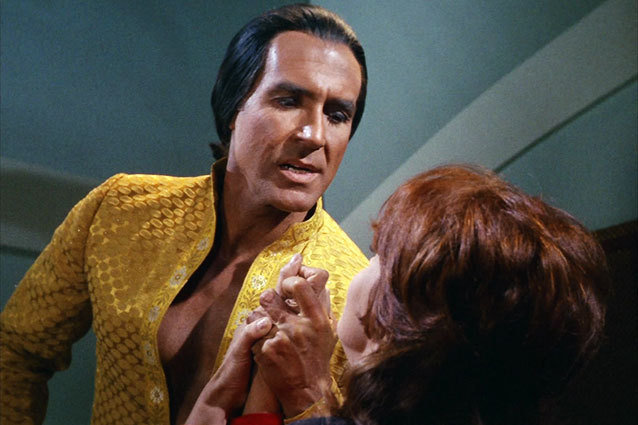
78. “Spock’s Brain” — The third season of The Original Series was a bit like the fourth season of Community. Its original creator, Gene Roddenberry, was marginalized so NBC could make Star Trek almost a parody of itself. That’s clear from the season opener, in which aliens remove Spock’s brain…because they can! Now, there are some good episodes in Season 3. But you’ll find that much of the bottom of this lost also comes from Star Trek’s wildly uneven last year.
77. “The Alternative Factor” — An early foray into the idea of exploring “parallel universes,” the Enterprise crew encounters a man named Lazarus who’s hellbent on tracking down his antimatter double from another dimension. When matter and antimatter collide it’s supposed to explosive, but the drama here certainly isn’t.
76. “Wolf in the Fold” — Scotty is accused of murder on an alien world! The kind of episode where you know he didn’t do it and you know he’ll inevitably be cleared so what’s the point? Stick around, though, for a supporting turn by the great John Fiedler.
75. “The Way to Eden” — Hippies in space! It could be a Muppet Show parody, but yes the Enterprise crew encounters 23rd century versions of the flower power set and have an incredibly reactionary response.
74. “The Paradise Syndrome” — Kirk is brainwashed into thinking he’s a Native American. Seriously.
73. “The Man Trap” — To his credit Roddenberry like to present non-humanoid alien threats as much as he did humanoid ones. But these parasites that leach off of the salt in human bodies (in the very first episode of The Original Series that aired!) are incredibly pointless.
72. “Elaan of Troyius” — Just from the title alone, you know this is going to be a bad episode. Kirk has to escort a spoiled princess through hostile terrain. A spoiled princess who loves to wear barely-there tinfoil jumpsuits.
71. “Mudd’s Women” — Jovial con man Harry Mudd is the kind of nemesis who only could’ve worked in the ‘60s. His introduction in Season 1 has him swindle dilithium miners out of their crystals in exchange for three beautiful women — three women who only appear beautiful when the miners are taking hallucinogens.
NEXT: Numbers 70-61 on our list.
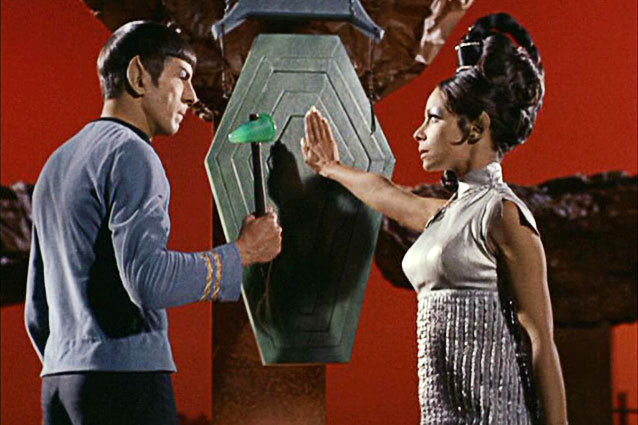
68. “Bread and Circuses” — The Enterprise crew encounter a planet that’s patterned itself on ancient Rome. Not the first time they’d discover a planet modeled on a violent period of Earth history, nor the first time they’d be forced to fight in gladiatorial games, “Bread and Circuses” reveals the tremendous capacity of the creators of The Original Series to repeat themselves.
67. “Return to Tomorrow” — Ditto for this Season 3 episode about telepathic aliens taking over Kirk and Spock’s bodies to build stronger, mechanical versions for themselves. Another thing Roddenberry loved over and over again? Non-corporeal aliens that can take over your mind!
66. “The Lights of Zetar” — Probably most notable for introducing the Memory Alpha station that lends its name to the Star Trek wiki. Again, “energy-based” life-forms are the threat.
65. “The Omega Glory” — Kirk faces down both an insane starship captain and a deadly plague while trying to stop an intertribal war. The umpteenth episode about protecting a less-advanced civilization that appears to reside in the rolling hills of Southern California.
64. “Friday’s Child” — Again, the Enterprise crew intervene in a tribal dispute that’s gotten out of hand, this time because of Klingon meddling. Most notable for McCoy’s immortal “I’m a doctor, not an elevator!”
63. “Is There In Truth No Beauty?” — An alien being the Enterprise is transporting must remain inside a black box because its physical form is so hideous. A Twilight Zone-style concept that could’ve been great in the hands of Rod Serling but just didn’t make a thought-provoking jump to the 23rd century.
62. “Plato’s Stepchildren” — So you already know one alien society patterned itself on ancient Rome. Here’s one that patterned itself on ancient Greece! But wait, wait, there’s more…
61. “Patterns of Force” — …Like this episode in which an alien civilization based its culture on Nazi Germany. At least here there’s some interesting commentary on how some ideologies are truly irredeemable, not just an opportunity to see Kirk wearing a swastika.
NEXT: Numbers 60-51 on our list.
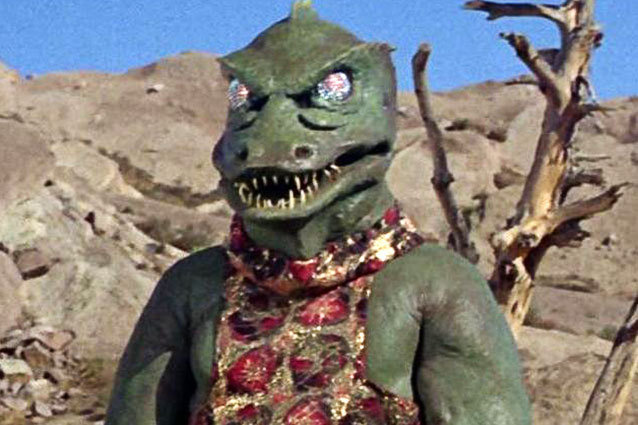
58. “Requiem for Methuselah” — Kirk discovers an immortal human living as a hermit. We liked this concept better in “Metamorphosis,” appearing higher on this list.
57. “The Squire of Gothos” — The god-like being Trelane, who patterns himself on an English gentleman from the 1800s, has complete control over the minds and matter of Kirk’s crew. We’d say it’s a whimsical concept, but it’s been done so often in Trek. All of these petty gods are building toward The Next Generation’s Q.
56. “And the Children Shall Lead” — There was an “evil imaginary friend” episode on Next Generation as well, but not nearly as crazy as this one, where a kids’ game of make-believe summons forces greater than Kirk could ever have imagined.
55. “That Which Survives” — A supercomputer is the only survivor of an alien race that succumbed to a deadly plague. It now chooses to represent itself solely as holographic projections of scantily clad women. Because it can!
54. “Obsession” — Kirk gets his Ahab on trying to track down the mysterious entity that killed much of the crew of his previous ship. A rare opportunity to go inside the good captain’s pre-Enterprise history.
53. “The Empath” — The Enterprise landing party are subjected to unfathomable torments to test an alien race’s empathic ability. The whole concept of “empaths” was another thing Roddenberry seemed curiously fixated on — see also the empathic Lt. Ilia in Star Trek: The Motion Picture and Deanna Troi in Star Trek: The Next Generation.
52. “The Gamesters of Triskelion” — The first and best of the episodes in which the Enterprise crew are forced to participate in gladiatorial games. The stuff Simpsons parodies are made of.
51. “A Private Little War” — Kirk tries to protect primitive aliens from Klingon interference. Not as exciting as “Errand of Mercy” or as unforgettably bizarre as “Friday’s Child” earlier on this list, it’s still really fun to see the Captain tangle with “those Klingon bastards.”
NEXT: Numbers 50-41 on our list.
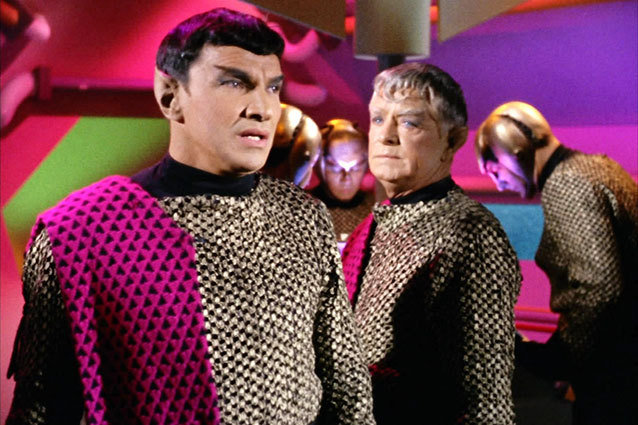
49. “For the World Is Hollow and I Have Touched the Sky” — An asteroid hurtles toward a Federation world and our heroes rush to prevent the collision…only to discover that the interior of the asteroid is inhabited by aliens who are totally oblivious of the universe around them. An engaging Russian nesting doll concept. Also, how could you not love any episode with this title?
48. “The Ultimate Computer” — Federation computer genius Richard Daystrom (he gets a shout-out in Star Trek Into Darkness) tests out a new artificial intelligence onboard the Enterprise. Catastrophe ensues. But it shows just how much Roddenberry was ahead of the curve when it came to operating systems and computer networking — just as he was with cell phones and tablets.
47. “Day of the Dove” — In case you were wondering, this the point in our list where we start getting into the good episodes. An energy-based alien life form that feeds off anger amplifies the tensions between the Klingons and Kirk’s crew, until the two adversaries finally realize what’s happening and turn against their common enemy. An early glimpse of the détente that the Klingons and Federation will one day achieve.
46. “This Side of Paradise” — A Federation colony that should have been wiped out by lethal radiation is actually thriving, its members living in a state of euphoria because of mysterious spores. However, those spores rob those affected of ambition and self-discipline, basically making them an early version of the dream-fulfilling Nexus cloud that’s central to the plot of Star Trek: Generations.
45. “Shore Leave” — One of Trek’s more hallucinatory episodes, “Shore Leave” presents the crew getting a few days of R&R only to find a white rabbit, a sword-wielding samurai, and Don Juan menacing them. Also, we learn Dr. McCoy really loves showgirls who wear rabbit-fur bikinis.
44. “The Savage Curtain” — The third to last episode of The Original Series is actually really thought-provoking as aliens force Kirk and Spock to join forces with figures of good throughout history (Abraham Lincoln, Surak) vs. historical figures of evil (Hitler, Genghis Khan, Col. Green).
43. “Spectre of the Gun” — Aliens force Kirk & Co. to play the losing side in a reenactment of the Gunfight at the OK Corral! Like “The Savage Curtain” it’s a challenging examination of the nature of monstrosity and whether it’s something that’s fated or learned.
42. “The Cloud Minders” — Star Trek created the original Cloud City, 11 years before The Empire Strikes Back. A vicious class disparity plunges a floating mining colony into full-blown civil uprising, all while the Enterprise crew race against the clock to recover resources they need to fight a plague.
41. “Where No Man Has Gone Before” — Roddenberry’s second pilot introduced Shatner’s Kirk and established the idealistic tone of the series: exploration of the universe as discovery of the self. Do you use the accumulation of knowledge for wisdom and self-improvement? Or for vulgar power like Gary Mitchell? Writ large, that choice could determine humanity’s destiny.
NEXT: Numbers 40-31 on our list.
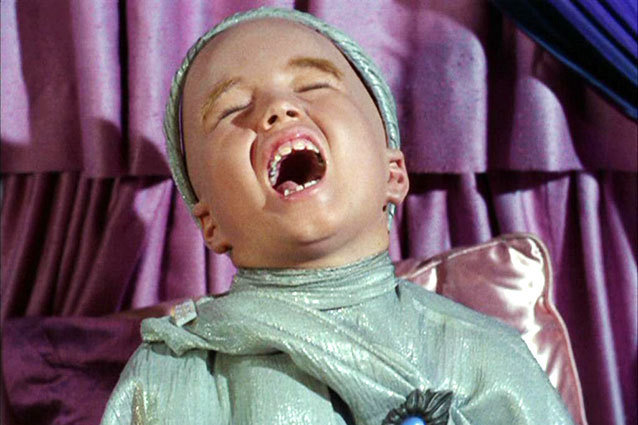
39. “I, Mudd” — What does Hary Mudd do when he has unlimited power? We find out in his second appearance on Star Trek, in which he has now become the king of a planet of androids.
38. “By Any Other Name” — More god-like beings! This time from the Andromeda Galaxy! They’ve taken over the Enterprise and modified it for the long, long journey out of the Milky Way. Shows how, even on The Original Series, Roddenberry and his writers understood the vastness of the universe.
37. “Who Mourns for Adonais?” — So guess what about all those Greek gods from mythology? They were real! Except they weren’t gods, but omnipotent aliens who passed through our solar system during the days of Priam and Achilles and meddled a little too closely in Earth affairs. Kirk & Crew encounter the last survivor of those wanderers, Apollo, who had been worshipped as the sun god. And trust us, it really went to his head.
36. “Operation: Annihilate!” — This is another time we actually delve into Kirk’s personal history. Unlike J.J. Abrams’ reboot, he grew up with his father, George, and brother, Sam. Only in this episode Sam gets killed by flying amoebas at his space colony. Remember what I said about things that like to leach off human bodies for their salt! Always a worry in the 23rd century.
35. “The Immunity Syndrome” — Speaking of space amoebas, the Enterprise almost runs smack into a giant, asteroid-sized paramecium floating in the void. It’s also draining power from the ship and threatening to suck it in, and the only solution is for Spock to try to meld with it. Okay, writing this right now, it sounds like the worst thing ever. But trust me, it’s unquestionably awesome!
34. “The Deadly Years” — Kirk & Crew are afflicted with a disease that causes rapid aging. For my money, if the producers of the current Trek franchise ever want to bring back William Shatner for a movie without a time-travel twist they’d infect Chris Pine’s Kirk with this disease and suddenly it’d be $#*! My Captain Says.
33. “The Changeling” — The Enterprise runs into a 20th century NASA space probe that may have already wiped out a couple worlds deep in the interstellar void. It overcame its crude 20th century programming and developed sophisticated, if psychopathic, artificial intelligence. I know, I know, it’s the plot of The Motion Picture, right?
32. “Let That Be Your Last Battlefield” — A powerful allegory for racial discrimination about a race of white-and-black aliens that shun certain members of their species depending on which sad is black and which is white. It may be a little heavy-handed for today’s sensibilities, but it was groundbreaking in 1969.
31. “Dagger of the Mind” — The ninth episode of the series is notable for being the first time Spock ever performs a mind meld. But it’s also a tightly-wound psychological thriller about a madman running an insane asylum.
NEXT: Numbers 30-21 on our list.
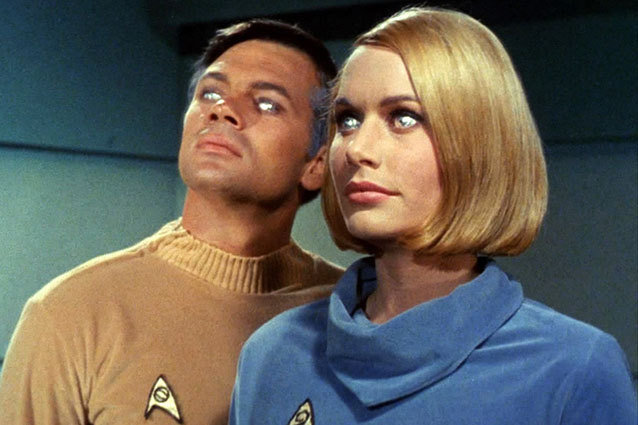
29. “The Conscience of the King” — Unlike Pine’s Kirk, Shatner’s grew up on the Earth colony at Tarsus IV. A colony that, in his youth, was ruled by a murderous governor who became known as Kodos the Executioner. Decades later in “The Conscience of the King,” Kirk suspects that a Shakespearean actor is actually Kodos in disguise. Also, yes, the name Kodos inspired one-half of the cannibalistic alien duo, Kodos & Kang, on The Simpsons. And just so you know, Kang was also a Kliingon on The Original Series.
28. “The Return of the Archons” — The Enterprise reaches the planet where the USS Archon was reported lost a century earlier and discovers that a society modeled on 19th century Earth civilization has sprung up. Unlike 19th century Earthlings, however, they live in fear of a telepathic being named Landru who wants to absorb them and the Enterprise crew into its collective.
27. “Wink of an Eye” — Invisible aliens that exist on a faster plane of time than we do — you could only glimpse them in the blink of an eye — take over the ship. Even with the limits on their makeup and special effects budget, “Wink of an Eye” shows how Roddenberry’s writers and directors could innovate, such as with the radical slow-motion technique they used once Kirk is on the same temporal wavelength as the aliens. Even a phaser beam is slowed down to the point of being dodge-able.
26. “Metamorphosis” — Kirk discovers the final hideout of Zefram Cochrane, the legendary pioneer who invented warp drive and made first contact with the Vulcans on April 5, 2063. But how could Cochrane (played here by Glenn Corbett and in Star Trek: First Contact by James Cromwell) still be alive 200 years later? Thanks to a glowing energy-based alien, of course, who’s keeping him prisoner while keeping him alive.
25. “Errand of Mercy” — The Klingons made their Star Trek debut with a warlike bang when they invade the peaceful planet Organia, inhabited by peasants who aren’t exactly what they seem. Kor, the leader of the Klingon invasion force, was played by John Colicos who came full-circle by playing the character once again on Deep Space Nine in 1998.
24. “Assignment: Earth” — For the first time, the Enterprise time-travels by slingshot-ing around the sun, something that would enable the events of the film Star Trek IV: The Voyage Home. This time they travel to 1968 Earth, where a time-traveler named Gary Seven (Robert Lansing) has been perceived to be altering history. Roddenberry had hoped “Assignment: Earth” would be the pilot for a Trek spin-off starring Lansing. That didn’t happen. It is notable for featuring one of the earliest appearances of a young Teri Garr.
23. “The Tholian Web” — The USS Defiant goes missing in hostile Tholian territory and the Enterprise is tasked with investigating. Turns out the Defiant is phasing out of our universe and into another dimension, and Kirk is trapped aboard. To make matters worse, the Tholians, screechy, insectoid aliens that fly crystal ships, have caught up with them and are building an impenetrable web around both Starfleet ships to prevent their escape. The best kind of race-against-the-clock thriller on Star Trek.
22. “The Enemy Within” — A transporter accident causes Kirk to be split into his good and evil selves. The former is mild-mannered but lacking initiative and resolve. The latter is undisciplined, aggressive, maybe even murderous. But neither can function on their own and both are necessary for Kirk to be a complete individual. The supposedly “evil” Kirk is strong, commanding, and decisive, qualities needed in a starship captain, along with the compassion and gentleness found in his “good self.” A provocative, value-neutral consideration of the qualities that make greatness.
21. “The Menagerie, Parts 1 & 2” — NBC recycled that old footage from Roddenberry’s first Trek pilot, “The Cage,” and made a much better episode. All the clips from “The Cage” became flashback video footage as Spock tries to explain before a Starfleet court martial why he acted in defiance of orders to help his old friend, and the Enterprise’s former captain, Christopher Pike.
NEXT: Numbers 20-11 on our list.
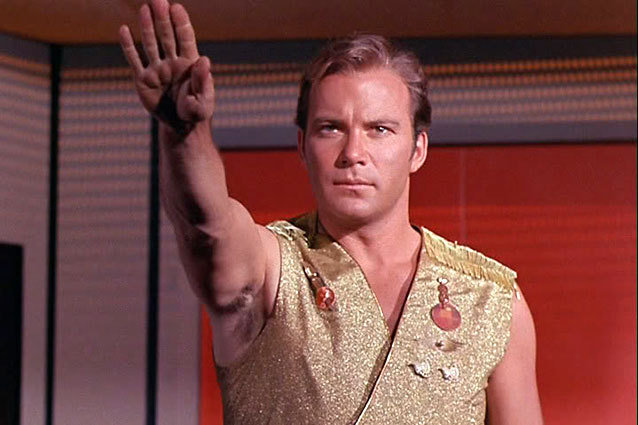
19. “A Piece of the Action” — The best of the “Alien Civilizations Modeled After Turbulent Periods in Earth History” episodes, “A Piece of the Action” takes us to a world modeled after the gangster culture of 1920s Chicago. But Kirk’s fuzzy fedora steals the show.
18. “The Naked Time” — A virus causes various members of the crew to lose their inhibitions and reveal their true selves: one becomes suicidal with fear and doubt about man’s place in the universe, another thinks he’s descended from Irish kings, and most famously, Sulu goes shirtless, grabs a foil and starts challenging everybody onboard to a duel. That’s because, as Spock puts it, Sulu is at heart “a swashbuckler out of your 18th century.”
17. “Tomorrow Is Yesterday” — An encounter with a black hole sends the ship back to 1960s Earth, in the first time-travel episode Star Trek ever attempted. The question is, can they mingle with 1960s humanity without altering history?
16. “A Taste of Armageddon” — A virtual war, but a brutal one, is being waged between two worlds solely by computer. Every so often members of each society must willingly sacrifice themselves as casualties in order to avoid actual nuclear warfare. The question is: how far are you willing to go prevent full-on war?
15. “All Our Yesterdays” — One of the most emotional Spock episodes, the Vulcan is trapped in the ancient history of a world doomed for destruction. He falls in love with one of its inhabitants before realizing that he has to make the return journey back to his own time.
14. “The Devil in the Dark” — A mysterious creature has been killing Federation miners. What is this menace? Turns out to be a silicon-based lifeform called the Horta and its just trying to protect its young from the miners’ brutish intrusion. Spock’s attempt to mind meld with the Horta is one of the classic moments of the series.
13. “Charlie X” — The second episode ever aired is a bold, primary-colored fantasia of ‘60s pop art. Kirk gives shelter aboard the Enterprise to a 17-year-old named Charlie (Robert Walker, Jr.) who grew up all by himself on an alien planet as the sole survivor of a spaceship crash. He developed psychic powers, however, which he is far from emotionally mature enough to use. And, oh, does he use them when he goes into a tantrum after not getting his way! He causes one Enterprise crewman to lose her face, causes chess pieces to melt, and has a really passive-aggressive workout with a shirtless Kirk.
12. “The Trouble With Tribbles” — A dispute between the Federation and Klingons over colonization rights to a planet get thrown for a wrench with the introduction of Tribbles, furry little pests with voracious appetites and an alarming birth rate. You’ve all seen the famous image of Kirk standing waist-deep in the critters, but the highlight of the episode may not be Tribble-related at all, but rather how easily the Klingons bait Scotty into a fight by calling the Enterprise “a garbage scow.”
11. “The Corbomite Maneuver” — A giant spaceship blocks the path of the Enterprise, its alien crew claiming that the Federation is expanding too quickly and will be halted in its march across the stars. It really looks like this could be the end of our five-year mission. But Kirk does what he does best. He bluffs. He says they’ve got a weapon called a “corbomite deflector” that will rebound all weapons fire directed to the Enterprise back to the firer. That gets the alien crew’s attention, so Kirk & Co. are welcomed aboard only to find it’s a crew of one: Balok, a jovial man-child played by Clint Howard, who resides in Bacchanalian surroundings and spends all day drinking tranya.
NEXT: The Top Ten
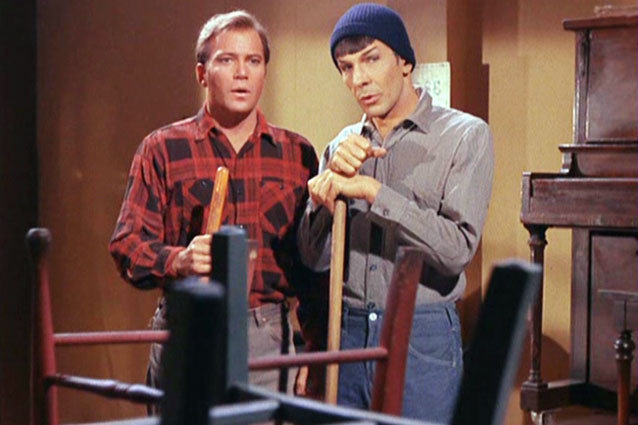
9. “The Doomsday Machine” — Kirk & Commodore Decker lead the hunt for a massive ancient weapon that can devour whole planets. For Kirk, it’s still a job. For Decker, it’s become akin to an Ahab-like obsession. The final moments of “The Doomsday Machine,” as Kirk is about to be swallowed by the monster and keeps telling his crew “Gentlemen, I suggest you beam me aboard,” are among the series’ very best.
8. “Journey To Babel” — The first time we ever get to see the founding races of the Federation — humans, Vulcans, Andorians, and Tellarites — in one place, this proposed peace summit becomes an Agatha Christie-style murder mystery. There’s nothing better than a Star Trek whodunit.
7. “Amok Time” — A.K.A. “Spock Gotta Have It.” Our Vulcan friend’s green blood turns hot when he enters the Pon Farr, the uncontrollable urge to mate that overcomes Vulcans every seven years. It can only be cured if the sufferer meditates, fights an opponent to the death, or has sex. The last option should be fine for Spock since he’s betrothed to T’Pring. But T’Pring’s heart turns fickle and she withdraws from their engagement, meaning that Spock has to fight it out — and he does so against Kirk!
6. “The Galileo Seven” — Spock’s away team is trapped on the surface of a planet surrounded by hostile natives, and their shuttlepod is damaged. A claustrophobic waiting game ensues, as the crewmen do everything they can to survive while waiting for rescue. Just about as suspenseful as any Star Trek episode ever.
5. “Space Seed” — Known now and forever as the episode that introduced Khan Noonien Singh (Ricardo Montalban) as Kirk’s greatest adversary, it’s also a pointed commentary on how far humanity has come even since (or especially since) the 20th century that produced Star Trek. Khan is a 20th century warlord who was genetically engineered with superhuman strength and intellect. But rather than transcend the petty ambitions and power struggles of Earth in that time, he lost himself in them. He’s a relic of a time — still our time in 2013 — when humanity cared more about power, prestige, and riches than enlightenment. Khan throws into relief everything that humanity tends to be…when we don’t strive to be anything more than what we already are.
4. “Balance of Terror” — Enter the Romulans. No hostile alien race in Star Trek, not even the Borg, had a greater debut than Spock’s pointy-eared brothers from another planet. What Khan represents to humanity — an unenlightened part of our history that we’d like to forget but do so at our own peril — the Romulans do to the Vulcans. Not to mention that “Balance of Terror” establishes the submarine-warfare aesthetic of all of Star Trek’s future space battles.
3. “Mirror, Mirror” — Take everything you know about the set-up of Star Trek then turn it on its head. That’s the idea behind the “mirror universe,” which presents doubles of our heroes living on another dimensional plane, doubles of our heroes with polar-opposite values, personalities, and skills. Rather than there being an enlightened Federation, Earth rules its corner of the universe as the barbaric Terran Empire. And we know they’re barbaric because of their incorporation of sashes, daggers, and bikini tops into their uniforms. Also, if you wear a goatee, you’re probably a doppelganger from a mirror universe.
2. “Arena” — The Gorn were only seen once in Star Trek until nearly 40 years later when they finally returned, given a CGI makeover, on Star Trek: Enterprise. But their first appearance, when it’s clear it’s just a dude wearing an unwieldy lizard costume, is their best. Godlike beings force Kirk and the captain of a Gorn ship who just ordered the destruction of a Federation colony to fight it out mano a lizard, to contain the bloodshed. Kirk’s final act is heartbreaking and beautiful.
1. “The City on the Edge of Forever” — Star Trek’s greatest episode has challenged all storytellers since not to use time-travel as a mere gimmick but as a prismatic tool for examining history and why we made certain choices along the way. Kirk & Spock travel back in time to 1930s Earth, looking for a drugged and psychotic McCoy, and meet a charity worker named Edith Keeler (Joan Collins) with whom Kirk quickly falls in love. She’s a forward-thinking 23rd century soul living in the midst of the Great Depression and dreaming of a future that Kirk knows will come true someday. But she’s doomed to die in a car crash within days. And, if Kirk doesn’t let her die, she’ll go on to lead a pacifist movement that will prevent the United States from entering World War II…allowing the Nazis to conquer the world. Edith has to die, so that the world she dreams of can exist. Time-travel has never been so emotional.
Follow Christian Blauvelt on Twitter @Ctblauvelt and follow Hollywood.com @Hollywood_com
Skip the “trek” to the theater and download the ALL-NEW Hollywood.com – Tickets & More app and discover a whole NEW way to buy tickets, starting with movie tickets.
Download for iOS: https://apple.co/3tiF0Jx
Download for Android: https://bit.ly/3yZcQa4
More:
STAR TREK DISCOVERY: THE FINAL SEASON: What Is, Was, Might Have Been and Still Might Be
Older Articles:
The Best of the Klingons from ‘The Original Series’ to ‘Into Darkness’ — VIDEO
Eight Things You Need to Know About ‘Star Trek Into Darkness’ In Advance
How ‘DS9’ Boldly Became the Best Most Influential ‘Trek’
From Our Partners:
 Zoe Saldana Strips Down For Magazine (Celebuzz)
Zoe Saldana Strips Down For Magazine (Celebuzz)
 33 Child Stars: Where Are They Now? (Celebuzz)
33 Child Stars: Where Are They Now? (Celebuzz)


